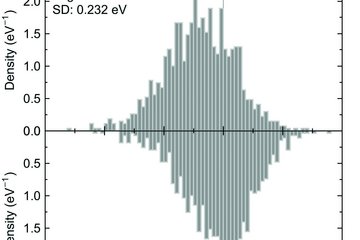All genres
1521.
Talk
Embrittlement effect in medium Fe–Mn alloys. Study of grain boundary segregation. Euromat 2013, Sevilla, Spain (2013)
1522.
Talk
Nanostructuring of bulk steels. International Conference on Computational Modeling of Nanostructured Materials - ICCMNM 2013, Frankfurt Institute for Advanced Studies, Frankfurt a. M., Germany (2013)
1523.
Talk
Characterization of Cu2ZnSnSe4 thin-film solar cells. Euromat 2013, Sevilla, Spain (2013)
1524.
Talk
Deformation Mechanisms in Ti–Nb–Zr–Ta–O alloys. Euromat 2013, Sevilla, Spain (2013)
1525.
Talk
High resolution strain mapping coupled with EBSD during in-situ tension in SEM. Interdisciplinary Center for Advanced materials Simulation (ICAMS), Ruhr-Universität Bochum, Bochum, Germany (2013)
1526.
Talk
The superplasticity evaluation of a Mn–Si–Cr alloyed steel at different microstructural and deformation conditions. Euromat 2013, Sevilla, Spain (2013)
1527.
Talk
Microstructural and Mechanical Characterization of Cold Work Effects in GUM Metal. 9th International Conference on Advances in Experimental Mechanics, Cardiff, UK (2013)
1528.
Talk
Analysis of 3D-EBSD Datasets Obtained by FIB Tomography. Microscopy and Microanalysis 2013, Indianapolis, IN, USA (2013)
1529.
Talk
Synthetic dental fluoroapatite/polymer-composite materials inspired by the hierarchical organization of shark tooth enameloid. 12th International Symposium on Biomineralization, Freiberg, Germany (2013)
1530.
Talk
The structure and composition of crocodile teeth. 12th International Symposium on Biomineralization, Freiberg, Germany (2013)
1531.
Talk
High performance lightweight steels. 8th Pacific Rim International Congress on Advanced Materials and Processing (PRICM-8), Waikoloa, Hawai, USA (2013)
1532.
Talk
Multi-scale characterization of advanced structural steels: from the micro to the atomic-scale. 8th Pacific Rim International Congress on Advanced Materials and Processing (PRICM-8), Waikoloa, Hawai, USA (2013)
1533.
Talk
Combining Structural and Chemical Information on the nm Scale by Correlative TEM and APT Characterization. Microscopy and Microanalysis 2013, Indianapolis, IN, USA (2013)
1534.
Talk
Atomic Scale Understanding of 6.8 GPa Ultra-high Strength Pearlite. 8th Pacific Rim International Congress on Advanced Materials and Processing (PRICM-8), Waikoloa, HI, USA (2013)
1535.
Talk
Stress-strain partitioning in martensitic-ferritic steels analyzed by integrated full-field crystal plasticity simulations and high resolution in situ experiments. GDRi CNRS MECANO General Meeting on the Mechanics of Nano-Objects, MPIE, Düsseldorf, Germany (2013)
1536.
Talk
Coupled high resolution strain and microstructure mapping based on digital image correlation and electron backscatter diffraction. IMPRS-SurMat Seminar, Meschede, Germany (2013)
1537.
Talk
Correlative EBSD-TEM-APT studies of GBs in Cu(In,Ga)Se₂ thin-films solar cells. Sfmu 2013, Nantes, France (2013)
1538.
Talk
Nano-to-macro-scale modeling of hierarchical biocoposites. SPP 1420 Summer School, UIm, Germany (2013)
1539.
Talk
Arthropod cuticle: A biological multi-functional composite used as template for nano-to-macro-scale hierarchical modeling. Seventh International Conference on Materials Structure and Micromechanics of Fracture, Brno, Czech Republic (2013)
1540.
Talk
Combined theoretical and experimental studies of ductile Mg alloys. Seminar lecture at the Technical University Bergakademie Freiberg, Freiberg, Germany (2013)











